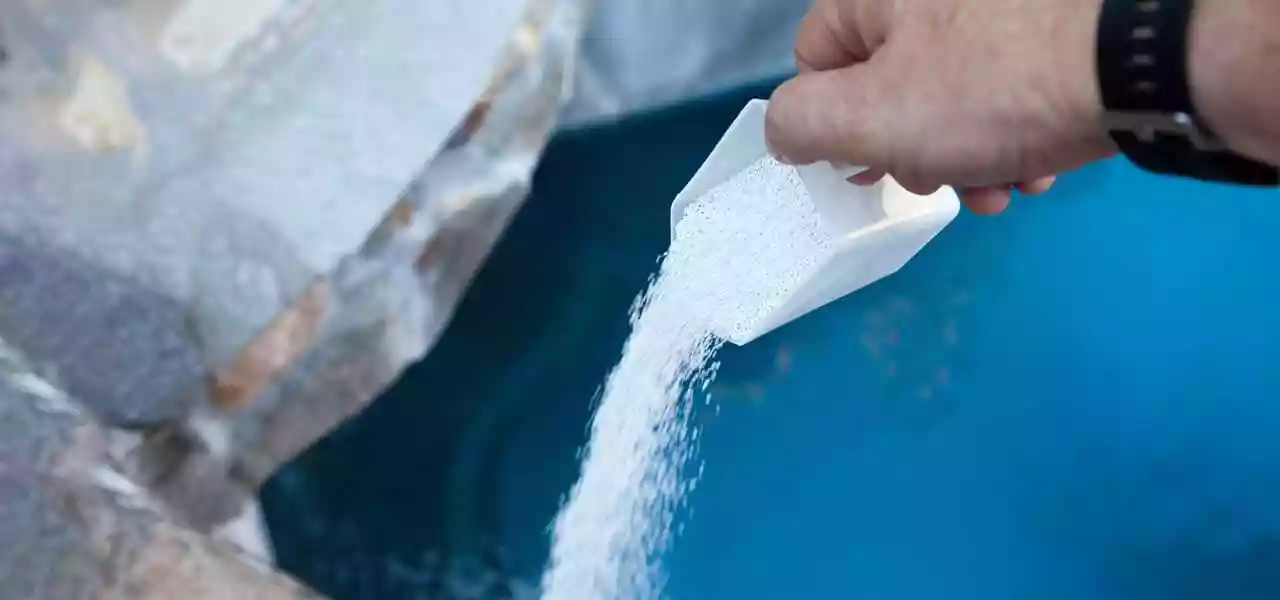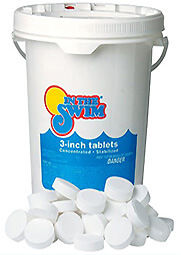FREE Standard Shipping On All Orders $100 or More!*

What Chemicals Are Needed for Pools?
Keeping your swimming pool clean and clear can be a tough job, especially if you don’t have the right chemicals. Keep the basics on hand for regular maintenance, as well as anticipated water problems.
This blog post lists all of the pool chemicals that every pool owner should be familiar with; at the end is a short list of pool chemicals that should be kept in stock.
Sanitizers:
As the name implies, sanitizers clean and disinfect your pool. There needs to be a certain amount of sanitizer in your pool water at all times. If sanitizer levels fluctuate, your pool will be at risk for developing problems. Chlorine is the most common form of sanitizer and comes in different forms, like liquid, tablets, or granular. Bromine, another type of sanitizer, works best in warm water, so it is a popular choice for hot tub owners.
Trichlor: 
Trichlor — available in tablets or sticks — is a solid chlorine that contains 90% available chlorine. This makes it the highest chlorine content product you can purchase. Trichlor is best used for daily maintenance, due to its high chlorine content and easy to use tablets. When placed in a chlorine float, the trichlor tablets dissolve over time, steadily releasing chlorine into your pool. Another perk of trichlor is that it is a stabilized chlorine. Meaning it contains Cyanuric Acid, which protects chlorine from the sun's UV rays, prolonging its effectiveness.
Sodium Dichlor:
Dichlor — available in granular form — is usually in granular form and contains 56% available chlorine. Dichlor also contains Cyanuric Acid, making it a great choice for outdoor pools exposed to the sun. However, dichlor contains more Cyanuric Acid than trichlor, making it not the best option for daily use. On the flip side, if your pool water is low in Cyanuric Acid, using dichlor will quickly raise the level until it is back within its ideal range.
Bromine:
Bromine — available in tablets — is similar to chlorine, but has a few key differences. Chlorine is known for its quick sanitizing abilities, but also for its quick depletion rate. Bromine, on the other hand, is much more stable than chlorine, especially in warm water. This makes it a top sanitizer for hot tubs and spas. However, bromine can be a burden on your wallet, as it often costs double the price of chlorine.
It's important to note that bromine and chlorine cannot be used together. If you use a chlorine sanitizer in your pool and want to switch to bromine, or vice versa, you will need to fully drain and flush your pool and equipment before switching.
Oxidizers:
Oxidizers, also known as pool shock, are the powerhouse pool water cleaners. They are used for heavy duty, targeted sanitizing treatments. Pool shock is commonly used before and after heavy pool use, after extreme weather events, or following any scenario where your pool water is exposed to contaminants. But you don't need to wait for a rainstorm or big party to shock your pool. If you routinely use your pool, it is recommended you use an oxidizer every couple of weeks to maintain cleanliness.
Calcium Hypochlorite: 
Calcium Hypochlorite, better known as cal-hypo, is a fast-acting oxidizer that wipes out algae, bacteria, chloramides, and other contaminants, in addition to boosting chlorine levels. When using cal-hypo, be mindful of your pool water's pH level. Cal-hypo will raise pH, so it's best to start with a low pH before adding shock. Because of the high chlorine content in cal-hypo, you should wait at least 12-hours after shocking before getting in the water.
Chlorine-Free Shock:
Besides the obvious lack of chlorine, chlorine-free shock differs slightly from chlorinated shock. Also called potassium monopersulfate, oxone, or potassium peroxymonosulfate, chlorine-free shock dissolves immediately in the water and leaves zero residue. This means you can get back into your pool almost immediately after administering this type of shock. Chlorine-free shock is also the only option to use if you use a bromine sanitizer. Because, if you recall from a few paragraphs above, chlorine and bromine cannot be combined.
Water Balancers:
Pool water balancers are used to increase or decrease the chemicals within your pool water. They aid in maintaining an ideal water chemistry balance in your pool. Testing your pool water weekly will keep you on top of how often you need to use water balancers.
pH Increaser & Decreaser: 
pH is an important chemical to have balanced in your pool water. If the pH level falls below 7.2 ppm, use pH Up to increase the level. To decrease the level, if it gets above 7.6 ppm, pH Down will lower pH about three clicks, from 7.8 to 7.5, in 10,000 gallons of pool water.
Alkalinity Increaser:
Total Alkalinity is another key chemical in your pool water, and works in tandem with pH. If TA levels fall below 80 ppm, use Alkalinity Increaser to raise TA by about 10 ppm, in 10,000 gallons of pool water.
Calcium Hardness Increaser:
Calcium hardness refers to how soft or hard your pool water is. If the scale tips too far in either direction, your pool can be damaged. If the calcium hardness level dips below 150 pm, add Calcium Increaser. One pound of Calcium Increaser will raise CH by 10 ppm, but always refer to the packaging for the proper dosing amount
Chlorine Neutralizer:
A chlorine neutralizer will decrease the chlorine concentration in your pool if it gets too high. One pound of Thiosulfate will lower free chlorine levels by about 10 ppm, in 10,000 gallons of pool water.
Chemical Combo Packs:
Pool chemical packages are kits that contain all of the basic pool chemicals you will need. Including chock, chlorine tablets, algaecide, and more. They are a great value and an easy way to get everything you need all in one go.
Specialty Chemicals:
Specialty chemicals are the chemicals you hopefully won't need regularly, but they are invaluable if you experience pool water chemical issues.
Algaecides:
Algaecides are either copper-based or non-metallic polymers. They help prevent algae growth and help eliminate algae if it does develop. Keeping pool shock and an algaecide on hand is the best way to stay ahead of any algae problems.
Clarifiers & Flocculants:
Pool clarifiers help clear your pool water of dirt and debris by clumping particles together, making them easier to filter or vacuum out. Similarly, flocculants attract particles into heavy clumps that sink to the floor for vacuuming to waste.
Enzymes:
Pool enzymes like Pool Perfect break down oils and other forms of non-living organic contaminants in your pool water.
Filter Cleaners:
Filter cleaners are used to clean sand, D.E., and cartridge filters. These cleaners help your filter run smoothly by removing oils, minerals, metals, and other filter clogging debris.
Phosphate Removers:
Products like PhosFree break down phosphates in the water. Phosphates are the main food source for algae.
Stain/Scale Removers:
Prevents or removes surface stains, scaling, and colored water due to minerals and metals in the water.
Tile and Vinyl Cleaner:
Tile and vinyl cleaners remove oils and grease build up around the waterline, or on furniture, skimmers, diving boards, and slides.
Startup Kits and Closing Kits:
When it comes to opening and closing the pool, or stocking up for the season, check out our chemical value packs that contain everything you need!
What Chemicals Should Be Kept On Hand?
As a minimum, the average pool should keep the following chemicals on hand. Even if you use a salt chlorinator, you will need these other pool chemicals from time to time:
- Chlorine tablets and pool shock
- Pool pH Up and/or pH Down
- Test strips or test kit
Every pool will also need chemicals to raise calcium, Cyanuric Acid or alkalinity levels, usually once per year. Clarifiers, enzymes, algaecides can be an important part of the overall routine, and are especially handy when you're in a pinch!
There's a lot to learn when it comes to pool chemicals! You may not need them all, but it's important to understand what they do, so that when you do need them, you know which chemical to use!
Safe swimming!